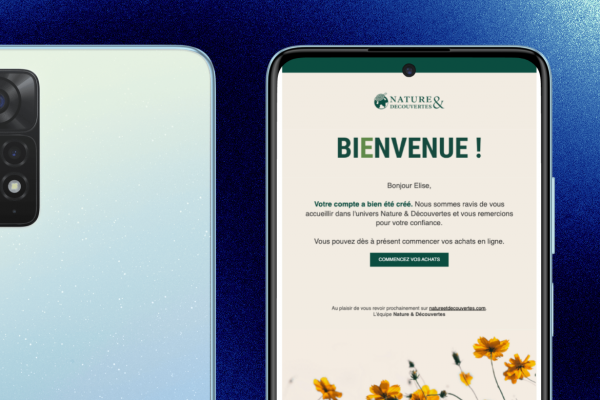More mobile conversions, more unimpeded data exploitation, innovations and surprises for customers: BUT had plenty of good reasons to choose our email builder.
Last September 27 was Lengow Day. At the Pavillon Gabriel in Paris, 400 top European managers of online and offline commerce met for an edition that focused on the customer journey. The topics included “Get to know your future customers,” “Think Better, Act Closer” and “Go Beyond your Achievements.”
In other words, this was right up our alley, so there was no way we would miss it! Which worked out well, since we had been invited. Our CTO Thomas Leroy, our Sales Director Pascal Bertoux and Audrey, eCRM Communication Manager for BUT (a client of both Lengow and Dartagnan) even ran a workshop together.
In particular, Audrey outlined the five reasons that motivated BUT to adopt our email builder three years ago. And to start using it more and more…
1. To resolve the matter of responsive design
Nowadays, 60% of French people check their email on their smartphones. But still, few of them make purchases via that channel (barely one sale out of five). For an e-merchant or retailer, therefore, there are great strides to be made for conversions, by making their campaigns responsive. This was the company’s first reason for using Dartagnan.
“It had become necessary for us to offer a better response to our customers’ expectations, in terms of their journey,” explains Audrey Raimond, eCRM Communication Manager at BUT. “In other words, we needed to be able to display our content on mobile devices.”
Over and above the importance that smartphones have assumed in the customer journey, the issue actually extends far beyond the question of whether or not an email is responsive. According to Litmus, there are some 1,000 different webmail providers around the world, approximately 250 mobile apps and many other purely-desktop applications.
The webmail (or email client) that the recipient uses to receive their messages, the device’s OS, the size of the screen, and so on, all combine to form some 15,000 possible configurations that can be used to read an email!
And Dartagnan offers players involved in smart commerce a user-friendly solution for creating templates and designing their emails. Plus, the release of an HTML code that is implemented in their routing tools, which will be compatible with more than 90% of the market’s email readers.
2. To “suffer” less in production
Email is an important – even vital – channel for e-merchants (for whom it can account for up to 30% of their revenue) and for retailers. But designing an email campaign is a thorn in the side of many of these players.
Whether they use email builders integrated with their routing tool (and so, for which they are not the core business), or whether they go back and forth with an agency that produces their campaigns, the process is lengthy, slow and often grueling… The figures speak for themselves: less than one out of every three advertisers is able to “produce” their campaigns in under three days, and 55% of them find themselves working on six or more emails at the same time. Following processes that can sometimes be… convoluted, to say the least.

Conclusion: Without the right tools, “email marketing teams spend three-quarters of their time on production, and the remaining quarter thinking about their strategy,” as pointed out by Pascal Bertoux, Dartagnan’s Sales Director. “Obviously, this is nonsensical…”
“At BUT, we were clearly suffering from this imbalance between production and strategy, before we started using Dartagnan,” Audrey Raimond confirms. “Especially since that tool does more than speed up the campaign creation phase.”
A Lengow-Dartagnan “bridge” for increased agility
Thanks to its integration with Lengow – which explains our presence at Lengow Day – Dartagnan has allowed BUT’s teams to save a lot of time on copywriting and on their final verifications before release.
Dartagnan’s email design interface makes it possible to integrate “dynamic feeds” (for example, feeds in .csv format from BUT’s Lengow catalog). And then, once the feed has been imported, a product presentation block can be created, containing relevant information from the feed (price, in-store availability, photos, etc.).
This provides a twofold advantage. Firstly, the information called by the email is always up-to-date, without the retailer having to go to the website for a final check before sending out the email. Secondly, the featured product can be replaced with a click, simply by changing its identifier (its EAN or SKU, for example), without having to re-create the product block from scratch. A much more agile design, with less risk of error: who could ask for anything more?
3. To better capitalize on its data
Any email marketer could ask for more: they would want to be able to make more of the data that their preferred customer relations channel is able to exploit. “BUT has a well-structured, well-segmented CRM database,” remarks Audrey Raimond. “We had long planned on using those data, but we didn’t have the tools – or the resources – to be able to produce a large number of campaigns in record time.”
With Dartagnan, this is not only feasible, but it can also be done in a way that is consistent with the brand’s conventions.
In-store traffic generation, cross-selling and up-selling: Increasingly effective triggers
In concrete terms, BUT has considerably diversified its communications. The retailer still sends out its traditional promotional email campaign, typically twice a week, to the broadest possible audience. But it also breathes life into some or so 50 campaigns based on the customer journey (triggers), namely including:
- cross-selling and up-selling campaigns
- for the customer’s birthday
- classically, after a user abandons their shopping cart, as well as post-navigation
- even local campaigns, based on the latest news and special offers from 300 brick-and-mortar stores, from a drive-to-store perspective, are simplified thanks to Dartagnan!
READ ALSO > Triggered emails: Get out of autopilot mode!
Triggered emails as carefully curated as “real” campaigns
Even “service” campaigns (order confirmation and tracking emails, etc.), which were used to be text-only and non-responsive, now receive the same careful graphic treatment as “real” marketing campaigns. And the code is always compatible with the latest developments in email clients.
“Triggers are one of the great opportunities for advertiser optimizations,” adds Pascal Bertoux. “We often tend to forget about them as soon as we design them. We track the statistics, of course, but we don’t worry about their technical compatibility with webmail and email clients, at least not for quite some time.”
Nevertheless, Gmail, Outlook and the others evolve very regularly, and with no regular code “clean-ups,” you are probably missing out on opportunities…
[#SuccessStory] Industrialize your responsive email production without creativity or design constraints with @DartagnanEmail and @But #LengowDay #GoBeyond pic.twitter.com/fLIGzdMKVn
— lengow (@lengow) 27 septembre 2018
4. To be able to test, measure and adapt
Email is a wonderful channel for exploiting customer data… but it is also capable of generating such data. “It’s very important to the success of a CRM or email marketing program that we listen to our customers,” Audrey Raimond notes.
To push this email performance measurement to the max, BUT conducts A/B testing on a regular basis. And to do this, it needs to produce more campaigns, with more available versions. Yet again, Dartagnan proved to be a very useful tool, in this regard…
Hot and cold email zones, unsubscribe tracking, spots with the most and fewest clicks and more… all the way to the web-to-store effect, on which emails read on mobile devices truly have a role to play: BUT is able to measure vast quantities of data, which it then uses to optimize its communications.
5. To innovate and surprise
Finally, BUT’s latest ambition for its email marketing: “to be ahead of the curve and offer our clients frequent surprises,” as Audrey Raimond puts it. “We all receive tons of emails, so it’s important to stand out and find that little thing that will motivate a reader to engage… That’s very important.”
Between carousels, burger menus, videos playable directly in the message and more, email offers a wide array of options for innovations. “But take note: there is no point to innovating for innovation’s sake,” warns Thomas Leroy, Dartagnan’s CTO. “If interactive content won’t beef up your marketing arguments, or if it will only complicate the interaction, you would be better off giving it a pass…”
This analytical work is all the more important, given that many email clients do not (yet) support the latest, most innovative formats. “So, you always need a fallback – a Plan B – for your campaigns’ interactive content,” continues Thomas Leroy.
All the same, in an environment as competitive as a potential customer’s inbox, you should never deprive yourself of the chance to amaze. And to make the most of the few seconds of attention that they are willing to give you. To manage this, you will need tools that allow you to refocus your energy on the most essential: defining your strategies, studying your target audiences and designing creative content.







Aucun commentaire pour l'instant